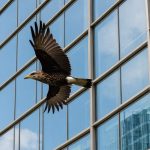Bird collisions with glass windows pose a serious threat to wildlife, particularly in urban environments. For UK residents living in high-rise buildings, it's vital to implement effective strategies to mitigate this issue. Innovative solutions can not only protect our feathered friends but also enhance the aesthetic appeal of our living spaces. Explore practical tips and community initiatives designed to create a safer environment for birds while maintaining the beauty and functionality of glass architecture. Join the movement towards bird-friendly buildings and make a positive impact in your neighborhood.
Understanding Bird Collisions with Glass
Bird collisions with glass windows in urban areas are a growing concern. These incidents often occur in high-rise buildings, where reflective surfaces can confuse birds. According to recent studies, millions of birds die annually due to such collisions, significantly impacting local wildlife populations.
Lire également : Boosting Bird Diversity: The Impact of Urban Greening Initiatives in UK City Centers
Ecological Impact
The ecological consequences of bird collisions are profound. Birds play a vital role in maintaining ecological balance, such as pollination and pest control. A decline in bird populations can disrupt these processes, leading to unforeseen environmental challenges. The loss of biodiversity due to these collisions is an issue that cannot be ignored.
Contributing Factors
Several factors contribute to the increase in bird collisions with high-rise buildings. The reflective nature of glass windows often misleads birds into perceiving them as open skies or foliage. Additionally, the proliferation of urban lighting at night can disorient nocturnal migratory birds, increasing the likelihood of collisions.
A voir aussi : Essential Tips for UK Birdwatchers: Protecting Rare Species During Nesting Season
- Reflective glass surfaces
- Urban lighting
- High-rise architecture
Efforts to mitigate these collisions include using bird-safe glass and adjusting lighting practices. By understanding and addressing these factors, we can significantly reduce the number of bird collisions, thereby protecting local wildlife and preserving ecological balance.
Effective Prevention Strategies for Glass Windows
Understanding the importance of prevention strategies is crucial for reducing bird collisions with glass windows. Various bird-safe glass technologies are available in the UK, designed to make windows more visible to birds. These include glass with UV-reflective patterns that are visible to birds but not to humans, effectively preventing collisions.
Window Treatments
Exploring practical solutions for safer environments.
Window films and decals offer an affordable and effective way to deter birds. These treatments create a visual barrier, breaking up the reflective surface of the glass. Applying these films in patterns can significantly reduce the risk of bird collisions.
- UV-reflective patterns
- Decorative decals
- Frosted films
Design Considerations
Incorporating safety from the ground up.
Designing with bird safety in mind is essential during construction. Architects and builders can integrate prevention strategies by using bird-safe glass and thoughtful building placement. By considering these factors from the outset, new constructions can minimize the risk to birds, preserving local wildlife.
Implementing these prevention strategies not only protects birds but also enhances the sustainability of urban environments. By adopting bird-safe glass and effective window treatments, we can create safer habitats for both humans and birds alike.
Behavioral Insights into Bird Movement
Exploring bird behavior and navigation in urban landscapes.
Analysis of Flight Patterns
Understanding bird behavior in urban environments is essential for developing effective collision prevention strategies. Birds often navigate using flight patterns that are influenced by various factors, including light and reflection. In cities, these patterns can be disrupted by artificial structures.
Case studies have shown that certain species are more prone to collisions due to their specific flight behaviors. For example, birds that fly at high speeds or those that are migratory may be more susceptible to misjudging reflective surfaces.
Influence of Light and Reflection
Light and reflection play a critical role in how birds perceive their surroundings. Bright urban lights can disrupt natural flight patterns, leading to increased collision rates. Reflective surfaces often create illusions of open skies, confusing birds and causing them to crash into windows.
Case Studies on Collision Prevention
Several case studies highlight successful strategies in reducing bird collisions. By adjusting lighting and using bird-safe materials, urban planners can significantly impact bird safety.
- Implementing non-reflective glass
- Reducing urban light pollution
- Designing buildings with bird-friendly architecture
These insights into bird behavior and flight patterns can inform future urban planning, creating safer environments for birds navigating complex urban landscapes.
Successful Implementation Examples
Exploring real-world applications of collision prevention strategies.
Review of Successful Projects
In the UK, several successful installations have demonstrated significant reductions in bird collisions. A notable example is the use of bird-safe glass in high-rise buildings like the Manchester Beetham Tower. This project incorporated UV-reflective patterns, effectively minimizing bird fatalities.
Key Features and Strategies
Key strategies in these projects include the application of non-reflective glass and the strategic placement of decorative decals. These features create visual cues that birds can recognize, reducing the likelihood of collisions. Additionally, reducing urban light pollution has been a priority, further enhancing bird safety.
- Bird-safe glass with UV patterns
- Strategic use of non-reflective glass
- Reduction of urban light pollution
Lessons Learned
Lessons from these innovative projects highlight the importance of integrating bird-friendly design from the outset. The Beetham Tower project revealed that even minor adjustments in glass design can lead to significant reductions in bird collisions. These best practices provide valuable insights for future developments, encouraging architects to prioritize bird safety in urban planning.
By implementing these best practices, urban landscapes can become safer for birds, ensuring their protection and promoting biodiversity.
Legal and Regulatory Considerations
Navigating the legal considerations surrounding bird collisions with glass is crucial for building owners. In the UK, several building regulations and environmental laws are designed to protect wildlife, including birds. These regulations mandate that constructions minimize their impact on local ecosystems.
Overview of UK Laws
The UK's Wildlife and Countryside Act 1981 is a cornerstone of wildlife protection, making it illegal to harm or kill wild birds intentionally. Building owners must ensure compliance with these laws to avoid potential liabilities. Environmental laws also require that new constructions undergo assessments to evaluate their impact on wildlife.
Potential Liabilities
Failure to adhere to building regulations can result in legal consequences for property owners. If a building is found to contribute significantly to bird collisions, owners may face fines or be required to implement corrective measures. Understanding these legal considerations can prevent costly liabilities.
Resources for Compliance
To assist in compliance, several resources are available to building owners. These include guidelines on best practices and access to expert consultations. Utilizing these resources ensures adherence to environmental laws and promotes wildlife protection.
- Wildlife and Countryside Act 1981
- Environmental Impact Assessments
- Compliance guidelines and consultations
Building owners must prioritize legal considerations to uphold environmental laws and protect local bird populations.
Visual Aids and Resources for UK Residents
Understanding the importance of visual aids in raising awareness.
Raising Awareness through Visual Aids
Visual aids are essential for educating the public about bird conservation. They help illustrate the impact of bird collisions and the effectiveness of prevention strategies. Tools such as infographics and educational materials can make complex information more accessible and engaging. By utilizing these resources, communities can better appreciate the need for protective measures.
Organizations and Resources
Several UK organizations focus on bird conservation, offering valuable resources. These institutions provide educational materials and support for implementing collision prevention strategies. Some key organizations include:
- Royal Society for the Protection of Birds (RSPB)
- British Trust for Ornithology (BTO)
- Wildfowl & Wetlands Trust (WWT)
These groups offer guidance and visual aids to help residents make informed decisions.
Tools for Assessing Risks
Advanced tools and software are available to assess bird collision risks. These technologies enable property owners to evaluate potential hazards and implement appropriate measures. Utilizing these resources can significantly reduce the risk of bird collisions, promoting safer urban environments. By integrating visual aids and expert resources, UK residents can play a proactive role in bird conservation.
Balancing Aesthetics and Bird Safety
Exploring the harmony between design and ecology.
The Design Challenge
Balancing aesthetics with bird-friendly architecture is a challenge for urban designers. While modern buildings often prioritize sleek, reflective surfaces, these can be hazardous to birds. The key is to integrate bird-friendly features without compromising the visual appeal of urban structures.
Innovative Solutions
Architects are adopting innovative solutions to maintain urban design aesthetics while ensuring bird safety. For instance, using non-reflective glass or incorporating patterns that birds can perceive helps prevent collisions. Another approach is the strategic use of green facades, which not only enhance beauty but also provide safe pathways for birds.
Recommendations for Architects
- Incorporate bird-friendly materials: Use glass with patterns visible to birds.
- Design with nature in mind: Consider the natural flight paths of local bird species.
- Engage with conservation experts: Collaborate with wildlife organizations to ensure designs meet bird safety standards.
By focusing on these strategies, architects and developers can create urban designs that are both visually appealing and safe for avian wildlife, promoting a sustainable coexistence between humans and nature.













